The street years at Watkins Glen were magic to me. In our house the trip to “the Glen” was a yearly pilgrimage. The excitement, the fun and the life experiences that I enjoyed with my father are never to be forgotten.
My Dad, Charles H. A. Davison, Charlie to his friends was a wonderful father in every sense. He was loving, attentive and caring to all four of us kids and he and my mother Caroline were married for nearly 60 years. There are probably still a few old SCCA Detroiters out there who will remember him and his enthusiasm.
I don’t know when dad was actually bitten by the sports car bug but as long as I can remember, cars were just part of our lives and by any standard I was among the most fortunate of kids. We didn’t have money but we had love, support and cars.
Among the characteristics that made him special was the fact that when it came to sports cars he had the enthusiasm of a 14-year old boy. His was badge number 18 in the Detroit Region of the SCCA, a group that assembled in 1948 at Little Harry’s Restaurant on East Jefferson in response to a classified ad in the Detroit News that announced that sports car lovers were convening there to form a sports car association which became the Detroit Region of the SCCA.
Dad didn’t have a sports car although provisional SCCA memberships were open to those who were not so fortunate as to own one. Full membership was limited to sports car owners. Most of the new Detroit Region members were provisional, or members that were enthusiasts but did not own a sports car. Detroit, after all, was the home of Chevys, Fords and Plymouths.
Everyone was excited to learn about the sports car race to be held in a small upstate New York town called Watkins Glen. The first running of the race was in 1948 but Dad decided not to travel the 600 miles to the Glen. I have to assume that while dad was a fanatic about sports cars and sports car racing, he had a job and four kids to feed. Priorities! Additionally, it was about this time that dad, who had been a technical illustrator for a company that created training and instructional manuals for the military, decided to venture out on his own to take advantage of the need for artists and illustrators to do the ads for cars and trucks for the auto industry. It was a big risk for him and for the family and such a trip was not taken lightly.
Dad was born in Chippenham, Wiltshire and immigrated with his parents to Canada shortly after WWI and finally to the US where he became a citizen in 1927. After the war his father, who returned to England before WWII, sent him a subscription to Motor Magazine and it was within those pages that names such as MG, Jaguar, Riley, Frazer-Nash, Lagonda and Allard became part of my lexicon.
In 1948 Dad replaced the old Hudson that he had driven through WW2 with an Austin A-40, a car created by the export-driven Brits to raise money for their rebirth as a nation. Dad bought the car from Falvey Motors, one of the first import car dealers in the area. Falvey Motors was located at the corner of Woodward Avenue and Long Lake Road in Bloomfield Hills, Michigan. It was a converted gas station and he squeezed in Jaguars and Hillmans along with Austins.
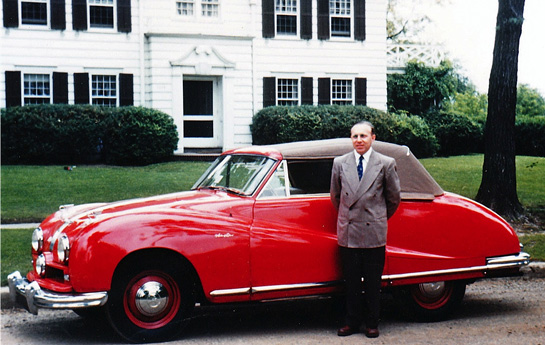
Larry Falvey, the local foreign car dealer, stands next to an Austin A 90 Atlantic in front of the Davison residence.
Like Max Hoffman, Larry Falvey was an Austrian immigrant and had been a competition driver in his home country before the war. He sold dad on the A-40 by taking him for a demonstration drive. He drove west on Long Lake until he came to a place in the road where he could see in both directions and the road was wide enough. He then cranked the steering wheel hard over and executed a full 180 turn at about 30 mph. Dad was impressed because he knew that any such maneuver in a Ford would result in disaster and wrote a check for the A-40 on the spot.
The A-40 had leather bucket seats, a four-speed transmission with floor-mounted shift lever and a 1200 cc motor that would turn to 5000 rpm when coaxed. It wasn’t a sports car but it surely was more fun than getting a Ford of that era and it cost less.
The A-40 served as his commuter car as well as a sporty vehicle for use in SCCA events. The Press on Regardless Rally was a Detroit Region event and we participated with the A-40. There was a British-style field trial in Oakland County’s Grampian Hills. Dad managed to not turn it on its side while negotiating the course. He did get it up on two wheels and I got what was to become a familiar admonishment: “Don’t tell your mother!” One night we removed the Austin’s muffler so that we could hear what a four-cylinder motor sounded like at 5000 rpm. The tach we added was proof that 5000 was attainable.
With participation in other Detroit Region rallies and trials I soon became familiar with names such as Alfa Romeo, Citroen and Fiat. An exhibition of French cars at Detroit’s Masonic Auditorium added Delage, Delahaye, Hotchkiss, Panhard, Renault and Talbot to the list of cars that I was familiar with and subsequently longed for.
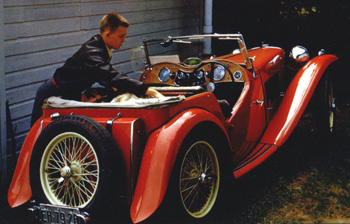
Harold Lance's MGTC with his brother tending to the car. Lance would take hundreds of photos and color slides at the Glen.
I will never forget the first MG that we saw. It was probably in 1947. We were driving back from Detroit on Second Avenue. Old Detroiters may remember that when Second crossed Six Mile Road it curved around to the right and then twisted back to the left (north) as it blended into Woodward.
We were driving yet another Hudson, this time it was Mom’s 1947 Super Six. Dad had worked for Hudson before the war and Ford and Chevy dealers were accepting payments just to be put on the waiting list for new cars. After a period of postwar shortages, Hudsons were available and with no extra fees.
Just after we crossed Six Mile Road, dad swept the car to the curb and jumped out.
“Come on, Eric, there’s an MG!” Sure enough, parked at a gas station was a red TC. The owner wasn’t around but we spent a few minutes in admiration while Dad gave me a thorough explanation of the fine points while the rest of the family waited in the car. The rest of the family was Mom, my older sister who really wasn’t interested and my younger twin brother and sister, ten years my junior.
While Birmingham, Michigan was a bedroom community for Detroit and hence, “Detroit Iron” oriented there was enough curiosity about the rare foreign cars that appeared. Plus, Dad was a favorite among my pals because of his enthusiasm. Any of my friends who hung around our house were soon converted or, at least became foreign car friendly.
October 1948 rolled around and although we didn’t make it to the Glen, Dad’s good friend and fellow SCCA member Harold Lance did go and he took lots of slides that were a feature presentation at the next SCCA meeting a Little Harry’s. Since I wasn’t old enough to go to Little Harry’s bar and restaurant, Harold Lance came to the house and we had a leisurely slide presentation. It was awesome. Alfa Romeos, Bugattis and a host of other sports and racing cars that had been in storage for the duration of the war were on the city streets of Watkins Glen. Some were raced and some were just there to be admired. It was like a revival meeting.
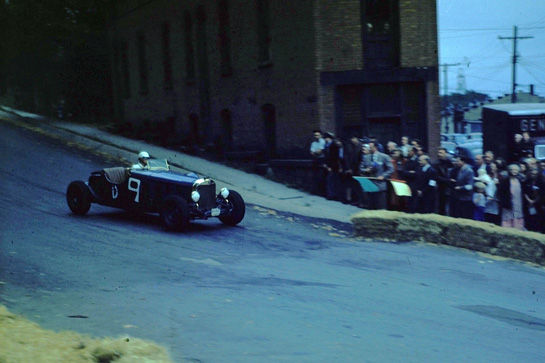
Cunningham in the Buick with a Mercedes body. The hot rod finished second. How could this be, they wondered? Lance Photo.
While a beautiful 2.9 liter Alfa was the winner of that first race, it was hard to generate much enthusiasm for the Cunningham entered BuMerc that finished second. Cunningham had raced the car prior to the war and here it was again. But for us it was hard to imagine a Buick doing anything on a race track.
At that time, what are now considered to be classics and treasured were just old cars. At the high school I attended there were at various times vehicles such as a V16 Cadillac roadster, a ‘32 Packard roadster and an Auburn Phaeton in the parking lot. These were just cars that people wanted to be rid of. Owners had suffered with them through the war and now that new Fords, Olds, etc. were available the lumbering old vehicles were put out to pasture for almost nothing; $40 for the Packard. A used car lot in town offered a Cord Beverly sedan with a missing fender for $200.
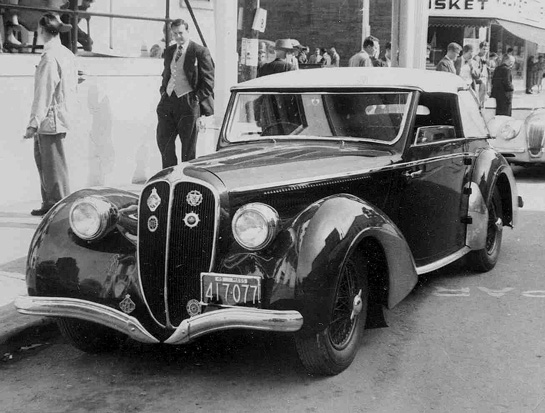
The Dumont Delahaye 135 M on the streets in 1949—it was entered in the 1948 race but was a DNS. Photo Frank Shaffer.
After Lance’s show, Dad was more determined than ever to get to the Glen and began to plan for the 1949 race.
Note: In the lead photo, George Weaver backs the Maserati V8R1 out of the truck at Smalley’s Garage, 1948. Harold Lance photo.
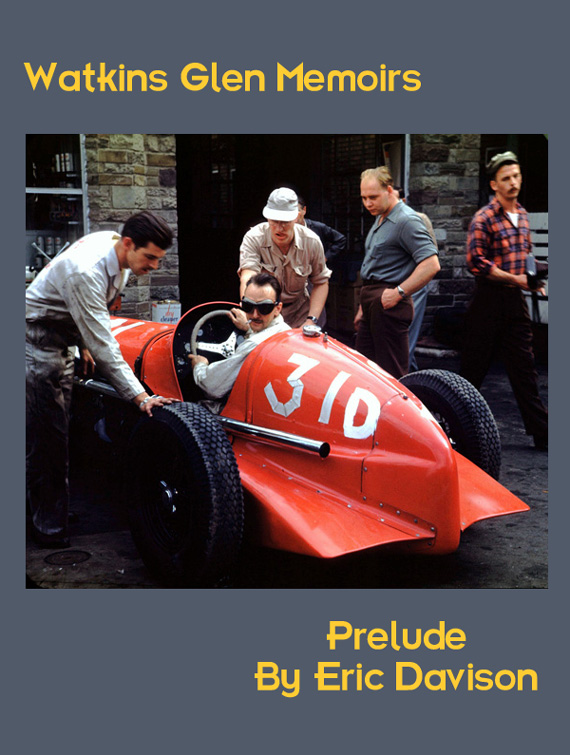
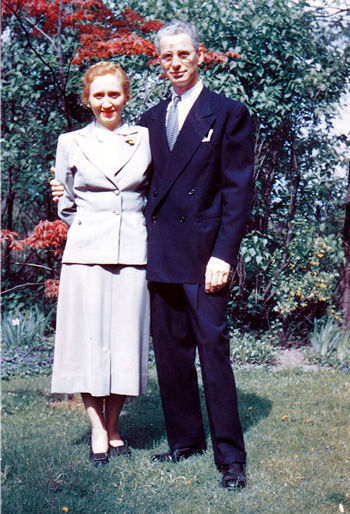
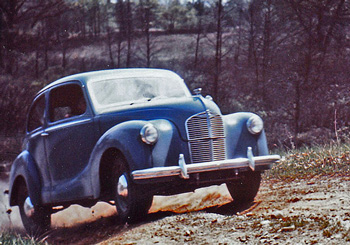
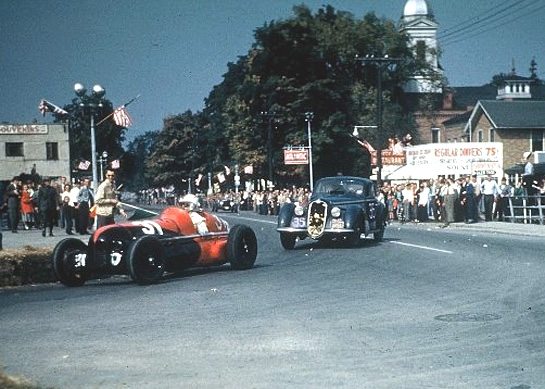
Without Harold Lance the “color” of Watkins Glen 1948 would not be avaialbe for us all to enjoy today.
Thanks to Eric Davison for sharing his personal experience and a Extra Big Thanks to Harold Lance for recording history and giving his sons the Sports Car Carzy Gene!
Clark Lance
What a marvelous time that was for imports gracing our shores. I’m a wee bit younger, but me neighbor’s Dad had Hillmans, Sunbeams and Sprites. They were cheap, fun and simple…notice I didn’t say reliable! I miss sports car rallies and especially the P.O.R. rallies we ran in east Texas in the 70’s.
Ahh, to be young again. Great story and rekindles great memories
Eric — What a fine memoir of early days at Watkins Glen. If you ever decide to publish the series, I would like to buy a copy. — Carl Goodwin
Great stuff, have you talked to are you involved with the IMRRC in Watkins Glen? Michael Argetsinger has done a great book on the USGP in Watkins Glen.
More please!
i remember well the 1948-49-50+51-52 events at the glen. i remember the famous bu-merc and the griswold alfa 2.9. also the later spectator fatality which closed down the round-the-houses action (i was up on the hill at the time when all the contestants were red-flagged).
i was a student in ithaca next door at the time.
one of my co-students had a packard twin-6 roadster, the one with the cubbyhole for yout golf clubs behind the door. he could occasionally get it running on as many as 11 cylinders. i think he spent so much time under the car he was a year late in graduating. can’t remember his name now, i had a ford coach 1935 vintage at the time.
but i did not have a suitable camera until 1954, so all my slides are later vintage.
> jack
I would also buy a copy. The photos are priceless!
Wonderful memories that so many others, including me, would love to have experienced ourselves. My father enjoyed distinctive cars, but they were not sports cars. My passion for cars was triggered by both genetics (on my mother’s side), my first visit to an annual auto show with my father; and my first “drive,” at age eight, was on my grandfather’s lap,when he took his hands off the wheel and allowed me to steer the car. The aberrant gene originated with my great-grandfather, who, beginning in about 1906, owned a series of Fiats sand a Pope-Toledo. He and two friends (and his mechanic/driver) actually drove cross-country in one of the Fiats in 1916. My grandfather had a 1912 Fiat Type 55 two-seater, with a 55-hp. 4-cylinder engine. In the 1950s, he favored Dodges and Desotos with V-8s. When he was 83, he took me aside one Sunday evening after driving to our house for dinner. After giving me that familiar “don’t tell your mother” admonition, he told me he had just taken his new Dodge up to 110 mph. on the then-new Baltimore beltway!
Lance’s great photo of Griswold’s Alfa chasing Weaver’s Maserati was taken a few feet from the spot where I snapped Erwin Goldschmidt’s winning Allard J2 slide around the first turn of that original Glen road course a year later. Author J.J. O’Malley included the image I caught on page 24 of his wonderful “The Glen ’98 – 50 Years of Road Racing Excellence.”
And I suspect Lance came to the same conclusion I did; that had to be one of the dumbest spots around the entire course we could have picked to shoot from.
What a great treasure for all of us Glen babies. It brings on a rush of long forgotten memories, good memories. Thanks
Nice to see the photo of Frank Griswold in the 2.9-liter 8C in 1949 even if he is following the Maserati. Steve Griswold, who ended up running an Alfa agency in Berkeley, was Frank Griswold’s son and introduced me to Giuliettas in 1959-1960, leading to a lifelong love affair.
Dear Mr. Davison,
I enjoyed your article about the early Watkins Glen races. I presently own the #5 car entered in the 1948 race.It is a BNC-Ford special campaigned at the time by George Caswell. I would like to know if you have come across any photos of the car. Being a little obscure, both driver and car, I haven’t been able to find many photos of it. It only appeared in the 1948 race. Before and after, it ran quite a few Hill Climbs and then dissapeared. I don’t have many records of this either since Sports Car Racing was still in its infantcy, and not many records were kept. Thank you, I look forward to your next article. George.
Wonderfully written remembrances. That time was a little before my first time at the Glen yet I remember it like it was yesterday. And, my first car was also an Austin A40 with the turn signal flags that popped out of the hidden crease in the middle area between the front and rear doors ~ what a hoot that was. After the A40 I graduated (?) to a Borgward Isabella and then to a Sprite. What great memories. Thank you.
Pete,
Thanks for the acknowledgment for my photos. The story of the A-40 sure rings a bell for me. One year we went to the Glen in a 1948 four door A-40 and I ended up owning it. The MG TC is the same story for me except it belonged to Cameron Agetsinger at Youngstown College. I visited Cameron at his home one evening and met his small boys. I told him I used Amale Motor oil and I got Cameron a case for about $8.00 and Cameron remembered it while he was still living at the Glen. I ended up with a TD when they came out and passed up a chance for an A-90 Austin (new for $2500).
It sure sounds like a great undertaking and a great book. Keep up the good work.
Frank
What a great human interest story and it was nice that it included cars, Watkins Glen, et al. I know I’ll enjoy the remainder of the series. After bumping around this stuff since 1958, I find that I now enjoy these kind of stories and especially the period photos. Thank you, Eric, for the beginning of a great story…
Neat article. When Steven Griswold restored the Weaver Maserati I was trying to find out the details of how I could restore my similar Maserati V8-RI. Steven let me spend a week with the car, as it was being worked on and I got many photos and dimensions of missing parts for my car. Later I was able to buy the remains of the original engine for my car when their restoration was complete. George Weaver had purchased my engine in the late ’40s from Andy Granatelli and used it for spare parts during his racing years in the early days of SCCA racing. The engine now sits proudly in its original chassis.
I loved the picture of Poison Lil George Weaver’s Maserati V8Ri which was a real icon of the formula libre races at the Glen. He probably led them all but seldom finished. In the end to keep Georges car running Phil Cade removed his engine..also a V8RI and installed a Chrysler hemi all for the sake of keeping at least one car intact.
The picture of my dad’s 2900B Alfa coupe with George leading it is also great
I would love to have a copy of this because I am in part responsible for his victory. Even as an 8 year old boy I had my hand in this sport. I was the unfortunate one who had to add the tolulene ( for octane enhancement) to the aviation gas purchased to give the Alfa its winning edge…….. The unfair advantage Pre Penske thinking! I wonder what OSHA would say to day about using child labor for this!!!! In any case the end justified the means!!!!! the cup came home to Philadelphia objective accomplished.
In later years I gave it to Briggs and his museum when it was in Costa Mesa.
As for Poison lil. In later years when I opened my restoration business in Berkeley Ca I got the chance to restore her for Barbra Weaver ,George’s wife. When the car was finished and running like a Swiss watch I sent it to the UK to do a race at Donington Park. Tom Wheatcroft invited Barbra to come to the race meeting and I believe paid her way. I remember they got on like a house of fire afterwards and for years to come. I stupidly thought with my expertise I had solved all the old problems. When the race started I took off like a shot and briefly challenged for the lead and then took a look in the rear view mirrors only to see a cloud of smoke.
I had seen this happen so many times at the Glen….history repeating itself! The problem were the cylinder blocks which split because they had been bored out to 4.7 litre to make the car more competitive when it raced at Indy. This had structurally weakened them.
After the race I thought Barbra would be completely overwhelmed by disappointment. Not so. She was so calm and full of understanding. I remember her exact words to me. ” Now you understand why we call her Poison Lil” I understood!!!
Thanks for this wonderful opportunity to jog the memory,
My Brother Frank …the bishop went for the commemorative brick laying at the Glen starting line with dad’s name in September.
Cheers from Italy
Ciao,Stephen
Are you limitting your esearch to the pre-1953 period? I know the whereabouts of the car which won the <1500cc race in 1953….
Great history – my first English car was a 1948 Austin A-40, too. We started going to the Detroit Auto Show and the Ford Museum Sports car Review about 1953 and on. In the mid 1960s I was manager of a BMC/BMW agency. We got he BMC cars from Falvey and the BMWs from the Wood brothers. Lots of great trips to Detroit for new cars and to visit with SCCA guys. Thanks for the write up.
Knowing Harold Lance was learning that I wanted to become a part of the sports car world. Having a ride around the Watkins Glen in the Davidson Lancia in 1954 helped e determine to start racing. With an MG license the Harold helped me get, I started with an Austin A-40 Sport., and a career with sports cars that has lasted until to-day.
Harold eventually forgave me for leaving the English cars when I went to Alfa Romeo in 1956.